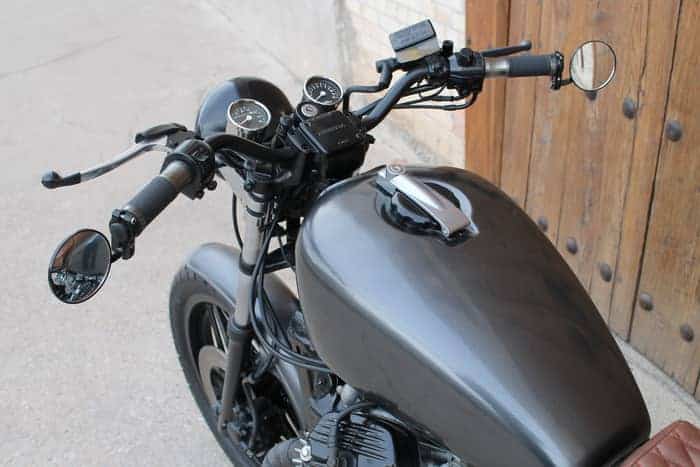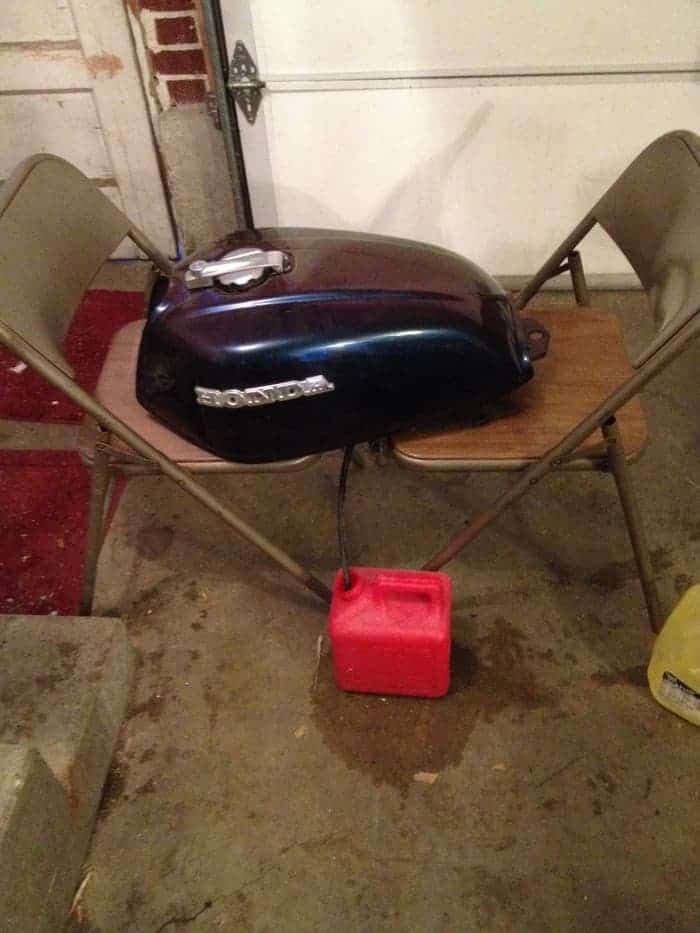
Motorcycles tend to be a bit more susceptible to the elements compared to other types of vehicles. Sometimes water will find it’s way into places on a motorcycle that it should never be in the first place.
It doesn’t take a scientist to know that water and fuel do not mix well; an engine simply cannot run properly when water is added to the mixture. Whether it was an accident or done on purpose, you may be wondering how to get water out of your motorcycle gas tank.
How do you get water out of a motorcycle gas tank? To get water out of a motorcycle gas tank, you can either completely dismount the gas tank and empty all it’s contents through the main hole or you can simply disconnect the fuel lines and let the gas drain from there. You’ll then need to add either some fuel stabilizer or rubbing alcohol to the tank, swish it around, and then drain it again.
There are several ways water can get in the tank of a motorcycle. I have restored a lot of motorcycles, some of which had been sitting in a field for years which lead to water getting in the tank. I can explain exactly how to get everything out of the gas tank and discuss other things you’ll want to know about it.
How To Get Water Out Of The Tank
Whether you’ve tried your best to prevent water entering your motorcycle gas tank or you were simply a little careless and water easily got it, just know that it happens to the best of us. As annoying of a problem as this is, it’s not completely unheard of to have a motorcyclist have this happen at least once throughout their motorcycle owning years.
The fuel system of a motorcycle is obviously an important part of how the motorcycle runs. If the motorcycle doesn’t get just the right amount of fuel and air mixture (with nothing else added), the motorcycle will get picky and not run exactly how it should.
If you suspect you have water inside your gas tank, there are a few steps you should take to ensure the water gets out of the system entirely. You will need to completely remove all of the fuel from the tank and system to ensure you get all the water out.
One method you can try is to simply remove the gas tank from the motorcycle completely, take off the gas cap, and tip it upside down. This will let all the fuel inside run out. Make sure to let it drain in a container that you are willing to dispose of.
Another and more popular way to remove all the fuel from the gas tank is from the fuel lines while the tank is still connected with the bike. You’ll need to disconnect the fuel line(s) (some motorcycles have one, others have two; disconnect them all).
You’ll need to take off the host clamp and turn your petcocks to the “on” position which will then let a stream of fuel drain from the tank. Again, make sure it is draining into a container you are willing to dispose of later.
Plan on getting rid of the gas that has been drained; in other words, do not plan on using it for something else because water in fuel isn’t good for any machine. You can dispose of gas by either taking it to your local recycling center or hazardous waste disposal center. Or you can usually take it in to an automotive shop who will also properly dispose of the gas for you.
Once the gas is completely emptied from the tank, turn the petcock to “off” and add a bottle of fuel stabilizer such as “Heet” which can be found at any auto parts store. If you are unable to obtain a fuel stabilizer, you can also use rubbing alcohol (but this should be your last resort). Swish it around inside the gas tank to ensure it has coated the entire inside lining of the tank and then empty the gas tank completely again.
Water is soluble with fuel stabilizers such as “Heet” or rubbing alcohol and these stabilizers are soluble with gasoline. These products are kind of like a middle man that can mix with both water and fuel. Essentially, it will attract any water that’s left inside the tank and will take the water with it once it’s drained from the tank.
If you have one, it’s possible for water to get in the carburetor as well. Since water is heavier than gas, the water will travel through the fuel lines first and could potentially enter the carburetor before the gas if you ran the motorcycle for a while before you discovered there was water inside the tank.
If you suspect water got in the carburetor, you’ll need to empty the bowl at the bottom of the carburetor (where the fuel sits). This can usually be done without having to take the entire carburetor off of the motorcycle. Spray some carb cleaner in the bowl as well as up inside the carburetor and let the bowl dry completely before reattaching it.

How Water Gets In A Motorcycle Gas Tank
There are a handful of reasons and ways water can find itself in the gas tank of a motorcycle. Most of the time it’s done unintentionally. But whether or not it was intentional, it is a problem that needs to be addressed quickly.
The most common way water gets into the tank is through the gas cap because the gasket on the cap is faulty. With rain, snow, sprinklers, car washes, etc., water will easily be able to get in if the gasket isn’t doing it’s job.
Sometimes there is a vent hole on gas caps. An old or low quality cap with a vent hole will also sometimes let water get inside the tank. If you suspect your cap is old and/or see the gasket is worn, get a new gas cap as soon as possible to prevent any more water from getting inside.
The third possible way water gets inside is if you simply forgot to put the gas cap on before some sort of storm or if you left it open over night and let condensation get inside.
What Water In The Fuel Can Do To A Motorcycle
Water that is mixed with the fuel inside the gas tank of a motorcycle can be dangerous and cause some serious problems for your motorcycle. That is why it’s so important to address the issue before it becomes an expensive fix for you.
Water in gasoline will cause poor combustion and can cause hydrolock inside the engine. When water goes from a liquid to a gas, it expands by a thousand times. For example, a single drop of water that turns into steam will expand a thousand times itself in the steam form.
Gas also expands itself when it converts from a liquid to a gas state, but not near as much as water does. Gas also ignites whereas water/steam does not. Since there is so much pressure inside the engine from the steam, the engine will not be able to combust properly which is when it hydrolocks, meaning the engine will become mechanically restrained.
Water getting inside the carburetor can also cause issues. When water gets mixed with fuel inside a carburetor, it can turn into a gooey-gel type of substance. This will potentially clog the jets which will also cause running issues such as sputtering or not being able to start the motorcycle at all. Click here to see my article about other reasons why a motorcycle sputters.
Symptoms Of Water In The Gas Tank
Sometimes it can be hard to tell whether or not water has gotten in to your gas tank. You can’t simply look inside and see if there’s water in there. There are a few symptoms you can look for if you suspect you may have this problem.
If your motorcycle has been sitting for a while and you know the spark and carbs are good but you struggle getting the motorcycle started, you may have water that has gotten inside the gas tank. Motorcycles that sit for a while without being used commonly have this issue. See my other article here about what else happens to a motorcycle when it sits for long periods of time.
If your motorcycle was working perfectly before and you noticed that overnight it is running poorly such as having issues getting it started or sputtering and acceleration issues while riding, you may have water that has gotten mixed with the fuel. Sudden changes like that are often caused by water getting in the tank from some sort of water source.
Related Questions
How long does it take for gas to go bad in a motorcycle? Unstabilized gas in a motorcycle can start going bad in about 30 days. The exposure to oxygen eventually changes the chemistry of gas which can lead to gum and varnish deposits. Gas should not be used if it has been sitting for longer than 6 months. Stabilized gas should not be used after 6-12 months. See my article here for more information.
How do I stop condensation in my gas tank? To keep condensation from getting in your gas tank, try to keep your tank as full as possible all the time. You can also add a fuel stabilizer that will be able to absorb the water before it starts mixing with the fuel.

